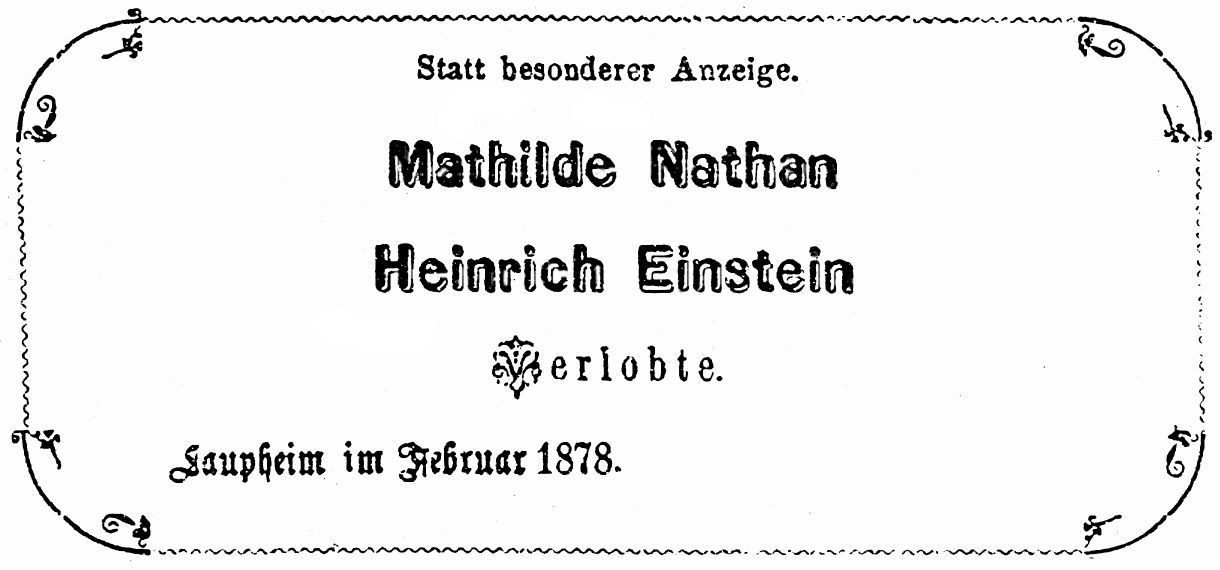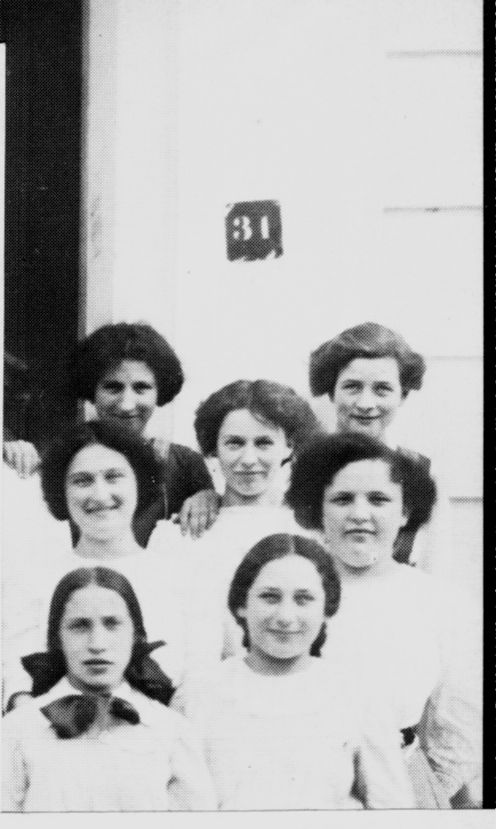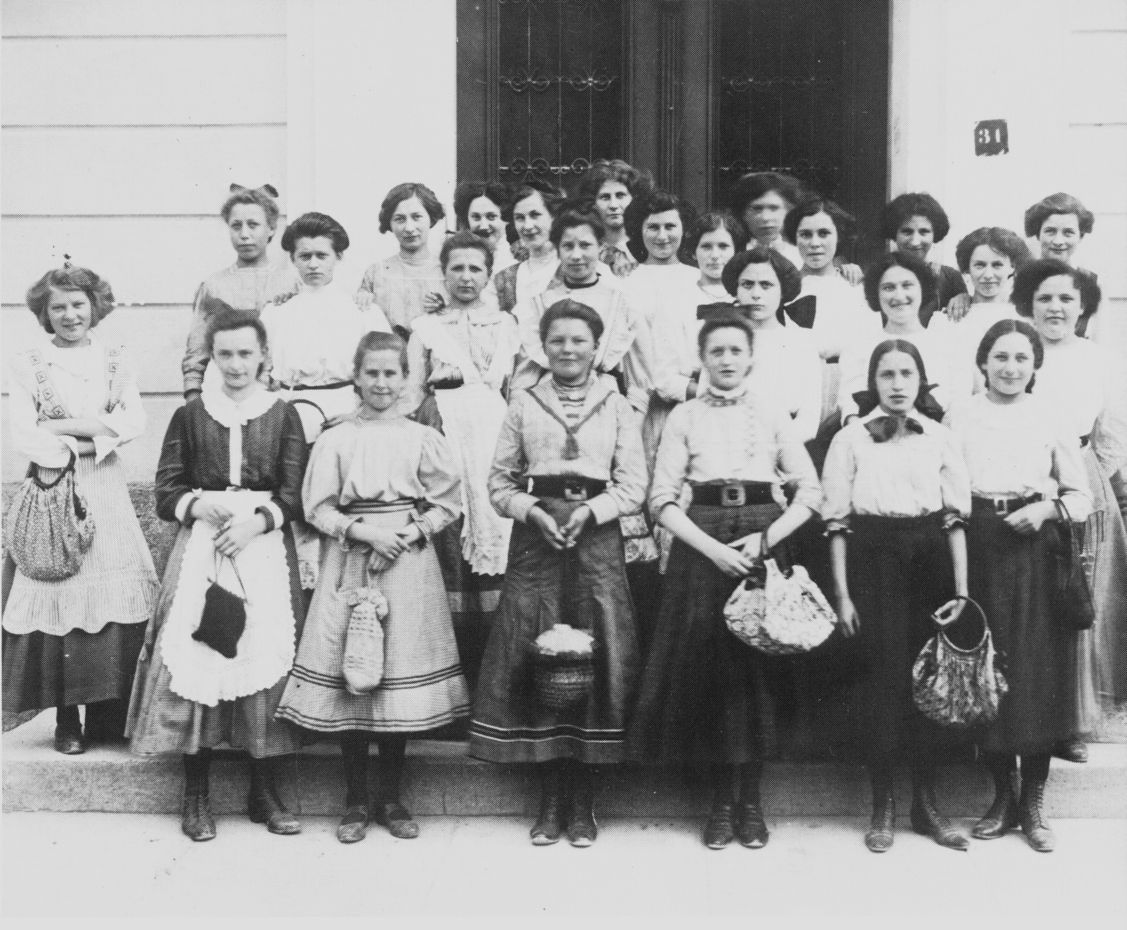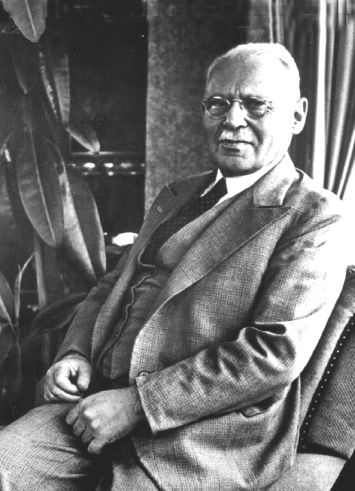 EINSTEIN,
Helene and Mathilde,
EINSTEIN,
Helene and Mathilde,
The Jewish
Community
of
La
Book Pages 162 - 165
 EINSTEIN,
Helene and Mathilde,
EINSTEIN,
Helene and Mathilde,
Translated by: Peter Ritz
KARL
NEIDLINGER
Mother: Mathilde Einstein, née Nathan, born May 13, 1856 in Laupheim, died March 7, 1937 in Laupheim. Widow of Heinrich Einstein, died 1909.
Daughter: Helene Einstein, born August 19, 1888 in Laupheim, single, murdered 1942 in Riga.
“While the Einstein family, at least in their first hundred years,
were not exceedingly successful economically, they excelled in any case
in
their fertility. Leopold (the Laupheim Einstein Ancestor, K.N.) and Esther
Einstein had three sons and at least three daughters who,
between 1786 and 1825, provably had 39
grandchildren , of which ten were male and all of them
founded families in Laupheim.”
(from: John H. Bergmann: Die Bergmanns in Laupheim,
page 22)
The Bergmann Clan had like all other
Jewish
families
in Laupheim
one common ancestor,
Leopold Einstein. Therefore John Bergmann dedicated
a whole chapter in his family chronicle to the Einsteins. The
fertility of the Einstein Clan,
which he drew attention to,
continued in the generations
that followed: Heinrich Einstein, a greatgrandson of Leopold had eleven
brothers and sisters, his daughter Helene was the youngest of his six
children.

In lieu of individual advertisement
Mathilde Nathan
Heinrich Einstein
announce their engagement
Laupheim February 1878
Advertisement in “Laupheimer Verkündiger” February
9, 1878
There is very little know about the family. Mathilde Nathan and Heinrich
Einstein married in the year of their engagement for their oldest daughter
Flora was born already in March 1879. Heinrich Einstein probably made a
living in the cattle trade and he built the estate Radstraße 8 with a barn
and a stable. Why he died at the age of 53 and how the economic situation
developed
remains unanswered. Except
for
his daughter Helene all his children left
Laupheim: They went to Switzerland, to the USA or married
and moved to
bigger towns like Ulm or Göppingen. That was also –
from
the middle of the 19th
century
not
just
an individual
case but rather the rule, not only with the Einsteins.
Thus only
parts
or
relics
of families can be
found in Laupheim in 1933,
which is
especially
true of
the Einstein family, despite their numerous offspring. Mathilde Einstein,
née Nathan, survived her husband
by
many years and died at the age of 87 in 1937. She was buried in her own
grave
in the
Laupheim cemetery, something that her youngest daughter Helene
who had spent her whole life with her mother was not granted.
In November 1941 Helene Einstein was deported to Riga where she was murdderet. At least her life is well documented with photos: As an elementary school pupil with her teacher Gideon in 1895 and as a graduate from the “Frauenarbeitsschule” (Women’s Housekeeping School) in 1913. This photo is fine evidence for the harmonious working and living together of Christians and Jews in town as was common at that time and which was brutally destroyed twenty years later. The “Frauenarbeitsschule” was a possiblity of further education for young women school- leavers, who were still single. It was held on Sundays and on a voluntary basis. Here Franciscan nuns conveyed practical knowledge and skills for future housewives. Women of all three denominations attended the school and – on their final photo in 1913 taken in front of the
 |
 |
| Helene Einstein as first-garder in 1895 | Helene Detail from |

The photo of the Frauenarbeitsschule is from Josef Brauns „Alt-Laupheimer
Bilderbogen“, Volume 1. Helene Einstein cannot be found on page 61 where all
the names are published: The assignment of names to the photo done by Braun
was later corrected by John H, Bergmann probably with the help of his cousin
Gretel Gideon. Thus Helene Einstein is most surely the lady in the center of
the´picture
detail
surrounded by Friedele Bernheim (above left, with a hand on her
shoulder), Alwine Dworzan (left), Salie Rosenberger (front left) Mina
Friedberger (in front of her), C.Levigard (to the right) and H. Löffler
(right behind her).
Helene Einstein remained
single,like at least three more of
the
women
of the dame age group.
This is surely not due to her
appearance as can be clearly seen. Portrayed are young Laupheim women of the
age
1888 to 1897: Their male counterparts had to enter World War I and many
did not return. The death toll of the German-Jewish community probably was
slightly higher than the average – despite that fact even during the war in
a slandering campaign the opposite was
maintained. In the Jewish community
too, the same amount of potential marriage partners were lacking as
with the Christians: To be the “Haustochter” (daughter in the household) was
the
fate not only for Helene Einstein.
On the morning
after the
pogrom night, on November 10th, 1938,thirteen-year-old
Rochus
König,
acted
in the parochial church of St Peter and Paul.
He lived at that time with his family in Radstraße. Their house entrance was
slightly to the side of the street in the back. That the synagoge burned
that night even his parents had noticed but
hadd not dared
to
go
out and to
switch on
a light. When he left the house in the early morning for his server
duty
it was dawning and he heard a low sobbing and weaping below the stairs.
Two women were hiding there and sat closely hugging each other and
trembling. He identified one of them: his distant neighbour Helene Einstein.
She had escaped from her house and sought shelter below the
stairs because she feared also to he dragged out of
her house by the ravaging SA and to be arrested. The boy of thirteen
was full of fear, too, and did not dare to help the two women but went to
church to serve there. The priest
also did not dare to say anything after the dreadful happenings of that
night and celebrated the service as if nothing had happened.
After the death of her mother in 1937 Helene Einstein became sole proprietor
of the estate Radstraße 8. One year later she
drew
up a last will and named
her youngest brother Leonard – who lived in Zürich – the
sole inheritor. The
continually aggravating measures of the NS-state against the Jews did not
stop and in September 1941 Helen was forcefully transferred to
Wendelinsgrube. Both apartments in her house were rented out by the town
from November 11, 1941, the barn was used from 1942 by farmer Karl Held. On
November 28, 1941 Helene Einstein was deported to the extermination camp
Riga where she was
murdered
in 1942.
Leonard Einstein, born August 19, 1887, the second youngest of the six
brothers and sisters married in 1935 Edith Beer in Frankfurt/Main and
shortly afterwards emigrated into Switzerland. He
was able to
make a living with
his family in Zürich. He became the director of the Nathan Institute. In
1948 he filed a restitution claim for the estate Radstraße 8. But as he died
in 1950,
it was
his wife and his children
who
were
granted restitutory rights to
the house and property of
Helene Einstein which they likely sold. Nothing is known of the whereabouts
of the personal property in the house and nothing is left.

Leonard
Einstein
(1887–1950),
Zürich.